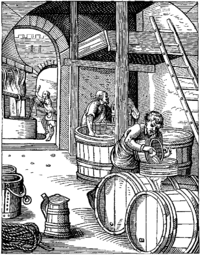
Photo from wikipedia
During winemaking, sulfur dioxide (SO2) is often added prior to the onset of alcoholic fermentation to prevent the growth of spoilage microorganisms and to create an environment that promotes the… Click to show full abstract
During winemaking, sulfur dioxide (SO2) is often added prior to the onset of alcoholic fermentation to prevent the growth of spoilage microorganisms and to create an environment that promotes the rapid colonization of the grape must by Saccharomyces cerevisiae. Most recent research has focused on the impacts of SO2 additions on spoilage microorganisms or on the yeast community at a species level, but less is known about the impacts that SO2 additions have on S. cerevisiae populations. We investigated whether different levels of SO2 addition at crush (0, 20, or 40mg/L SO2) have an effect upon the relative abundance and composition of S. cerevisiae strains conducting spontaneous fermentations of two grape varietals at two commercial wineries. Yeast isolates collected from fermentations were identified to the strain level using microsatellite analysis. Commercial strains made up the majority (64-98%) of the S. cerevisiae strains isolated during fermentation, and most of these commercial strains were used as inoculants by their respective wineries. Different SO2 additions were found to significantly alter S. cerevisiae strain compositions at both wineries (p≤0.002). The results of this study demonstrate that initial SO2 addition significantly alters the S. cerevisiae strain composition in spontaneous fermentations, and highlights the dominance of commercial strains in commercial winery environments. Because different yeast strains are known to produce different chemical and sensory profiles, our findings have important implications for winemakers. In addition, adding different concentrations of SO2 may be a way for winemakers to manage or control the strain composition during spontaneous fermentations.
Journal Title: International journal of food microbiology
Year Published: 2017
Link to full text (if available)
Share on Social Media: Sign Up to like & get
recommendations!